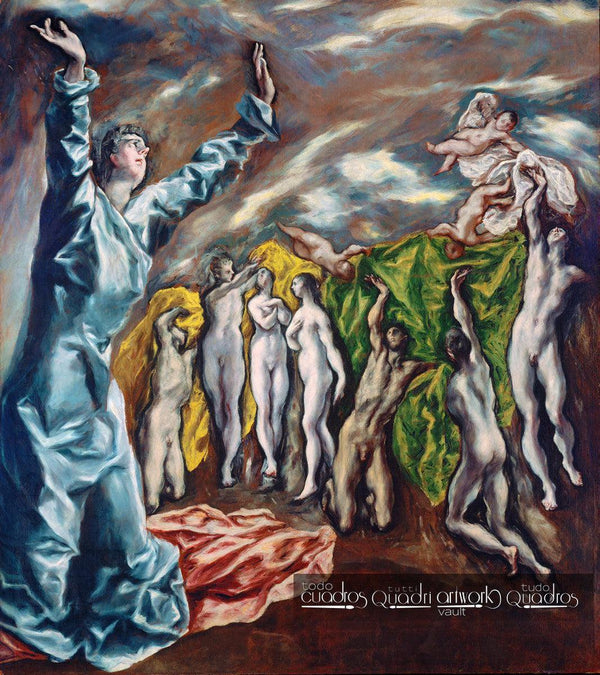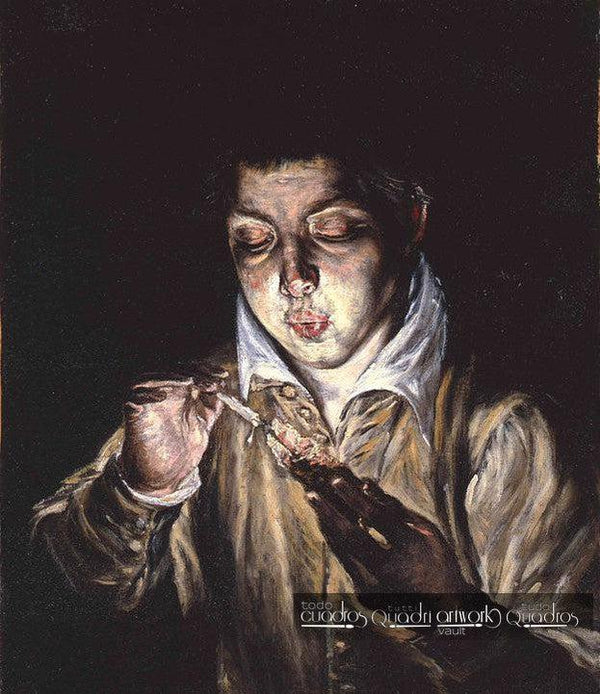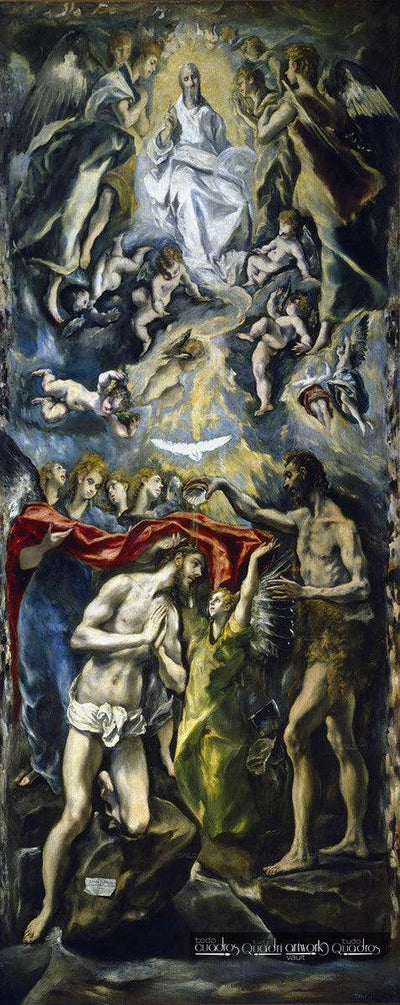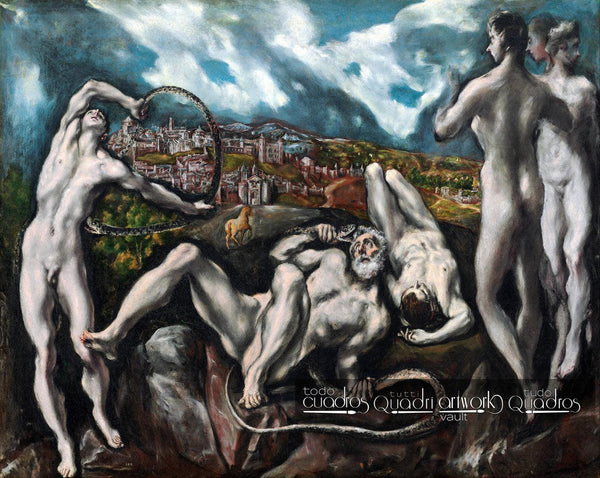El Greco

| Name: | Doménikos Theotokópoulos. |
|---|---|
| Also known as: | El Greco. |
| Nationality: | Republic of Venice. |
| Year of birth: | 1541, Island of Crete. |
| Year of death: | 1614, Toledo. |
| Style: | Mannerism, Renaissance, Venetian School. |
Doménikos Theotokópoulos, widely known as El Greco, painter born in 1541, in Heraklion, now the capital of Crete (Greece), which at that time belonged to the Republic of Venice. At the age of 26, he moved to Rome, where he learned from the Renaissance school and especially from Titian. At the age of 36, he moved to Toledo, where he ended his days.
El Greco is currently considered one of the greatest geniuses of universal pictorial art.
In his time, he was considered an extravagant who marked his own stylistic path without too much talent, largely due to what was formerly seen as a flaw and is now discovered as a virtue: his unique way of using colors, painting stylized figures and elongated forms.
Works of El Greco
The unique characteristics that the artist used in his painting, even allow to identify his paintings at first glance, are recognized today as a genuine medium that the artist used to give figures and characters, a strong emotional component, taking the expressiveness of forms to a higher level.
-

Author: El GrecoStyle: RenaissanceTheme: Biblical SceneType: PaintingTechnique: OilSupport: CanvasYear: 1614Located in: MET Museum, New YorkAlso known as "Vision of Saint John", it is a painting in which the artist worked for 6 years, and finally finished it in the year of his death: 1614.
It was made to remain in the Cathedral of Toledo, the original painting included large portions of canvas that are not preserved today, nor is it known exactly how they were.
When the painting was still in Spain, it was seen by Pablo Picasso, who described it as premonitory of modernism, and it has even been speculated that Picasso was inspired by it to create his famous canvas "Les Demoiselles d'Avignon".
-

Author: El GrecoStyle: RenaissanceType: PaintingTechnique: OilSupport: CanvasYear: 1572Located in: Capodimonte Museum, ItalyAlso known by the title "Boy Lighting a Candle", it was painted in oil on canvas in 1572.
A work of Mannerist style where the magnificence of the artist as a portraitist can be observed. It also displays a total mastery of lighting and the incidence of light on the face. The motif of the work is enigmatic: a boy lighting a flame in a dark and seemingly cold space. The origin of the idea is not clear, but the artist repeated it several times throughout his career.
It is currently located in the Capodimonte Museum, Italy.
-

Author: El GrecoStyle: RenaissanceGenre: PortraitType: PaintingTechnique: OilSupport: CanvasYear: 1580Located in: Prado Museum, MadridThis is the author's work that has had the greatest influence on Spanish art and culture. Painted in 1580, the identity of the man portrayed is not known for certain, however, he is considered as a gentleman representative of honor and integrity dressed in the fashion of the second half of the 16th century.
It is a half-body portrait of a gentleman of honorable appearance, with a calm, almost disdainful gaze, making a gesture of oath with his right hand. With the left hand he holds the sword, of which only the hilt is visible. The style of the painting is Mannerist, that is, it uses compositional elements of the great masters of the High Renaissance.
-

Author: El GrecoStyle: RenaissanceType: PaintingTechnique: OilSupport: CanvasYear: 1587Located in: Santo Tomé Church, Toledo.Undoubtedly the most complex and symbolically rich painting by the artist. This Mannerist oil painting dates from 1587, and was commissioned to depict a miracle that existed in the popular memory of Toledo at the time: the descent from heaven of Saint Augustine and Saint Stephen to bury the body of Lord Orgaz.
The painting is presented as a theological and descriptive allegory of heaven (upper half) and earth (lower half).
It was painted for the parish of Santo Tomé (Toledo), and it is in this same church where it is currently preserved.
-

Author: El GrecoStyle: RenaissanceTheme: Biblical SceneType: PaintingTechnique: OilSupport: CanvasYear: 1600Located in: Prado Museum, MadridThere are 2 versions of this painting, of which this is the earlier and better-executed one. The second (1608) was made with the intervention of Jorge Manuel, the painter's son.
It depicts the biblical scene where John the Baptist is in the Jordan baptizing Jesus, who is painted with the characteristic features that El Greco imprinted on his characters: elongated bodies and somewhat small heads. At the top appears the open sky and the white dove descending upon the Messiah.
The work was completed in 1600 and is currently located in the National Prado Museum, Madrid.
-

Author: El GrecoStyle: RenaissanceGenre: PortraitType: PaintingTechnique: OilSupport: CanvasYear: UnknownLocated in: "Pollok House", United Kingdom.The authorship of this oil portrait is not agreed upon by specialists, however, one of the main possibilities is that it was painted by El Greco.
At first glance, the usual shapes and brushstrokes of the artist are not identified, instead, it appears as an almost academic portrait, which was not the norm for the painter but still possible.
-

Author: El GrecoStyle: RenaissanceTheme: Classical MythologyType: PaintingTechnique: OilSupport: CanvasYear: 1609Located in: National Gallery of Art, Washington, USA.A mythological-themed painting done in oil on canvas in the year 1609.
The artist was primarily a religious painter, his representations of ancient legends are rare, this is one of them, where he masterfully manages to confer high expressive intensity to the characters. The sky is created with the same technique and color as the painting "View of Toledo".
-

Author: El GrecoStyle: RenaissanceGenre: Religious PaintingType: PaintingTechnique: OilSupport: CanvasYear: 1598Located in: Prado Museum, MadridA painting completed over three years and finished in 1598, it merges three incompatible elements in its geography and temporality: the apostle, the saint, and the Toledo landscape.
It is very well preserved, showing well-defined figures and vivid colors.
-

Author: El GrecoStyle: RenaissanceGenre: Religious PaintingType: PaintingTechnique: OilSupport: CanvasYear: 1580Located in: Prado Museum, MadridAn oil on canvas work, painted in 1580.
In it, one can observe the initial style of the painter, strongly influenced by the Italian classics. It is considered one of the works where the Mannerism is most evidently observed.
-

Author: El GrecoStyle: RenaissanceGenre: Religious PaintingType: PaintingTechnique: OilSupport: CanvasYear: circa 1579Located in: Cathedral of Toledo, Spain.Painted between 1577 and 1579. It is a complex work imbued with Christian symbolism, considered one of the artist's masterpieces.
-

Author: El GrecoStyle: RenaissanceGenre: Religious PaintingType: PaintingTechnique: OilSupport: CanvasYear: 1580Located in: Museum of Santa Cruz, Toledo, Spain.This work, along with "The Holy Face", displays one of the most important Christian relics, the Veronica's veil, painted in 1580.
-

Author: El GrecoStyle: RenaissanceTheme: LandscapesType: PaintingTechnique: OilSupport: CanvasYear: 1604-14Located in: Museum of Santa Cruz, Toledo, Spain.This is one of the first oil landscape paintings in history, as the genre did not exist before the Renaissance. Although at first glance it does not show great detail or illuminated figures on the horizon, to which the modern Western eye is accustomed, the work is considered brilliant, especially in the achievement of the sky and the high contrasts used to represent it.
Check it out in the store, section El Greco oil paintings
Related:
↑Back to Top
